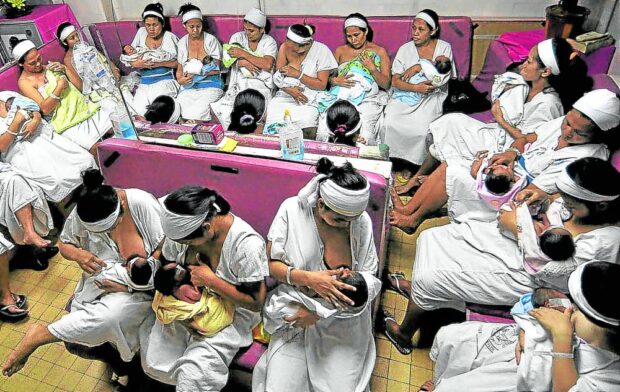DOH braces for more women giving birth in hospitals

NURSING MADONNAS | Newly born babies are breastfed by their mothers at Jose Fabella Memorial Hospital in Santa Cruz, Manila. (FILE PHOTO)
MANILA, Philippines — The Department of Health (DOH) expects more pregnant women to go back to health facilities for their natal checkups and birth deliveries after pandemic restrictions were relaxed and awareness of public health increased.
Dr. Diego Danilo Jr. of the DOH disease prevention and control bureau said the trend of pregnant women accessing public maternal care services was bound to only go up in the coming years as the government fully implements the Universal Health Care Act (UHC).
“We’re happy to see that facility-based deliveries are increasing. And this only means that this will not dip anymore,” Danilo said in a virtual Kapihan session on Friday.
The latest DOH data showed that facility-based deliveries significantly improved from 85 percent in 2017 to 92 percent in 2018. It slowly slid to 91 percent in 2019 and 89 percent in 2020. By 2021, it inched up to 90 percent.
Antenatal and postnatal checkups, which are crucial in detecting possible complications and ensuring the safety of the mother and her baby, were heavily affected by the COVID-19 curbs. In 2020 when the pandemic started, antenatal care fell to 83 percent from 87 percent the previous year. It slightly recovered to 84 percent in 2021.
Article continues after this advertisementPostnatal care access also dropped to 86 percent in 2020 from 93 percent the previous year. It then improved in 2021 at 91 percent.
Article continues after this advertisementDanilo attributed this to more patients “being aware” of the healthcare services available at government health facilities as provided for under the UHC. “They are not scared anymore to give birth at facilities,” he noted. “All services will be paid for, whether the hospital is public or private … as long as the provider is accredited by PhilHealth (Philippine Health Insurance Corp).”
He also pointed out that prenatal and postnatal checkups are also covered by the state insurer’s packages. “There is no reason not to give birth at a facility,” he added.
The current trend, Danilo said, is “a good indicator” as the Philippines aims to meet the United Nations’ sustainable development goals of bringing down the maternal mortality ratio (MMR) to 70 by 2030.
In 2021, the country’s MMR was at 84.86, based on data of the Philippine Statistics Authority. Among regions, maternal deaths were highest in the Zamboanga Peninsula and Metro Manila at 150.38 and 150.32, respectively.
These were followed by the Bicol region (144.02), Cagayan Valley (96.85), Ilocos (88.27), Central Visayas (86.81), and Western Visayas (73.30).
In the same forum, Dr. Maria Stephanie Cagayan of the Philippine Obstetrical and Gynecological Society noted that hypertensive disorders topped the causes of maternal deaths in the country at 31 percent in 2020.This was broken down to eclampsia, or seizures or coma during pregnancy, at 16.9 percent and pre-eclampsia at 14.2 percent.
Other causes of mortality were abnormalities of forces of labor and puerperium infections, both at 8.7 percent; postpartum hemorrhage (8.6 percent); other maternal diseases (7.7 percent); maternal infectious and parasitic diseases (5.3 percent); obstetric embolism (3.9 percent) and ectopic pregnancy (3.6 percent).